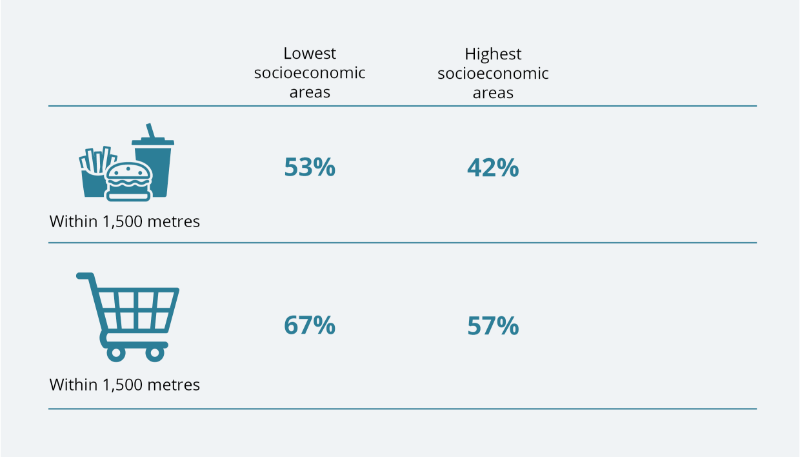Summary
The design of neighbourhoods can influence our health in various ways. It can affect how much physical activity we do, our access to nutritious food, where we work, our contact with nature, and the spaces we have for social interactions. These factors can affect health risk factors, such as obesity, and the associated risk of developing chronic conditions, such as cardiovascular disease and diabetes.
This report examines whether selected elements of the neighbourhood environment are associated with socioeconomic disadvantage and health risk factors. It explores how a person’s socioeconomic position and proximity from where they live to fast-food outlets, supermarkets, and public open spaces are associated with obesity, insufficient physical activity, insufficient fruit and vegetable consumption, and daily consumption of sugar sweetened drinks. The report uses the 2017–18 Australian Bureau of Statistics’ National Health Survey and looks only at Australian adults aged 18 and over.
The effects of population density (that is, how many people live in the neighbourhood) and the distances they travel to work are also examined.
Australian adults living in the lowest socioeconomic areas tend to have a higher prevalence of obesity, lower adherence to national physical activity guidelines, higher consumption of sugar sweetened drinks, and lower consumption of fruits and vegetables, than those living in the highest socioeconomic areas (ABS 2018c; AIHW 2020c, 2020d, 2020e).
Previous research has investigated whether greater proximity to fast-food and lack of accessibility to public open spaces are why it is difficult for people living in disadvantaged areas to undertake healthy behaviours, with mixed results (Fleischhacker et al. 2011; Jones et al. 2009; Thornton et al. 2016).
This report shows that these factors do not necessarily account for the inequalities in health risk factors often observed for people living in the lowest socioeconomic areas. While shorter commuting distances and increased population density were generally associated with lower prevalence of health risk factors, the relationship between health risk factors and proximity to amenities was complex.
People living in the lowest socioeconomic areas generally had the greatest access to both major fast-food outlets and supermarkets (see Figure 1).
Figure 1: Proportion of adults aged 18 and over who lived within 1,500 m of a fast-food outlet or supermarket, by socioeconomic area

Proximity to these amenities, generally, was not associated with obesity or inadequate fruit or vegetable intake. Additional neighbourhood factors, such as population density and commuting distance, were associated with inequalities in obesity and insufficient physical activity levels.
The prevalence of obesity generally decreased as population density increased for those in the middle to highest socioeconomic areas.
Living in an area with an average commuting distance to work of between 5 and 10 km was associated with lower prevalence of obesity (26%) and insufficient physical activity (48%) compared with living in an area with an average commuting distance of 20km or more (38% and 55%, respectively).
This report focussed on the proximity of amenities to where people live, it might not necessarily capture all the amenities people may use. For example, people could access a fast-food outlet near their place of work, rather than near their place of residence.
Examining additional components of the neighbourhood environment, such as the quality, and safety of public open spaces, may help policy-makers and health providers develop more targeted strategies to improve health-related outcomes for the Australian population.
Summary
1 Introduction
- The neighbourhood environment and determinants of health
- How common are health risk factors?
- What is Australia doing to address health risk factors?
- How does the neighbourhood environment influence risk factors?
- What measures did we use?
2 Characteristics of the neighbourhood environment
- Distance from nearest amenity
- Average commuting distance
3 Obesity
- Population density and obesity
- Distance from nearest amenity and obesity
- Average commuting distance and obesity
4 Insufficient physical activity
- Distance from nearest public open space greater than 1 hectare and physical activity
- Average commuting distance and physical activity
5 Dietary intake
- Fruit and vegetable consumption and amenities
- Sugar sweetened drinks and amenities
6 Future research and data limitations
- Data limitations
Appendix A: Technical notes
Data source
Data quality statement
Measures
- Socioeconomic areas
- Fast-food outlet and supermarket classification
- Public open space classification
- Population density
- Mean and median commuting distance to work
- Obesity
- Insufficient physical activity
Statistical analyses
- Crude prevalence estimates
- Age-standardised prevalence estimates
- Standard error, relative standard error, margin of error and confidence intervals
- Significance testing
End matter:
Acknowledgements, Abbreviations, Symbols, Glossary, References, List of figures, Related publications



